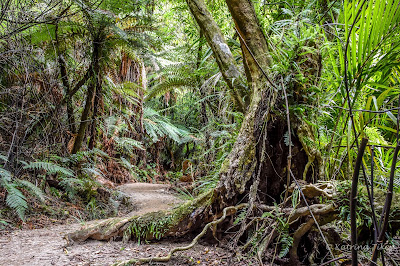The drive around the bays and beaches to Wainui Falls was and is spectacular. Pohara Beach, with a grey, sandy shoreline that stretched for
miles, was our first port of call. Many families flock here during the summer holidays as it must be ranked as one of New Zealand's safest beaches. It's little wonder the Pohara Motorcamp was bursting at the seams with campers. Tents and caravans were so close you could stretch out an arm and touch your neighbour!
Tarakohe Harbour is just around the corner from Pohara. This rock-walled
harbour was built by the Golden Bay Cement Company to ship cement made out of
limestone from the quarry across the road. The quarry and works are now closed,
however the wharf and harbour are still used for barging dolomite that is
quarried elsewhere in Golden Bay. The fishing and scalloping fleet unload and
anchor here, and there’s also a marina for commercial and pleasure boats.
 |
| Looking back towards Pohara with Tarakohe Wharf behind. |
In 2009 fifty nesting boxes were installed at Tarakohe Harbour
to provide housing for penguins. They were dug into the newly created
breakwater to discourage the penguins from crossing the road in search of nest
sites, and to provide a safe place for them to live.
From here the road sweeps under a rocky limestone archway before
winding and twisting it's way to Ligar Bay. On a full tide this bay is stunning. Golden
sand and plenty of space are an inviting feature. It’s very tidal - when the tide
is out there’s a bit of a walk to reach water deep enough for a dip.
After Ligar Bay is Tata Beach, well known for its golden sand
and deep water. It’s popular for water skiers and kayakers. A destination often
paddled to, are the Tata Islands, Ngawhiti and Motu Islands. These islands formed
from limestone, have steep cliffs and archways. They're also a safe haven for colonies of seabirds.
Wainui Bay is the next bay along. It’s another safe beach with
golden sand - and a great spot to collect mussels and/or explore rock formations. Only a stones throw from here is the turn off to the Wainui
Falls walk.
From the carpark the track crosses farmland for a short distance.
After crossing a few small creeks (however after a rainfall, I'm sure they wouldn't be quite this small) the track moves into native bush and there's a gradual climb to a point where you see the river far below. The walk continues through a forest of nikau palms, rata trees, pungas and ferns.
It’s an easy 40 minute return walk along a well maintained track. A swing bridge provides a spectacular view of huge boulders and the river below.
A few minutes after crossing the swing bridge I heard the roar of the waterfall. A fine, misty spray curtained the falls making the rocky path around it damp.
If you're keen for a swim you can plunge into the pool at the base of the waterfall. It's a popular walk during summer so there are usually people standing where you can view the entire length of the waterfall - be prepared to wait.
The walk back was along the same track - the bush was simply stunning. I couldn't help but stop every few minutes to take photos.

As I came to the end of the walk I stumbled across a track, partly concealed by vegetation, leading down to the river. I followed it, to find someone had created stone pillars balancing precariously on top of river rocks.





























Beautiful photos Katrina. Physically I'm not able to complete these walks but it's lovely being able to see them through someone else's eyes
ReplyDelete